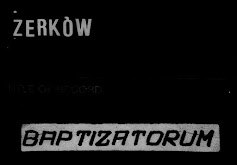Running into unexpected research problems in the guise of a temporary computer glitch can be frustrating. I suspected yesterday that that was indeed the type of problem standing in my way, but my optimism was a wee bit too cheery. Returning to the BaSIA website today did not magically make my problem disappear. Just like yesterday, when I clicked on the side bar revealing the location of the actual document used to transcribe information on my great-grandfather's Gramlewicz kin in Poland, I got an error message. This problem is not going away.
There was another way around the problem, of course. Jumping over to the other Polish website I've been using, the Poznan Project, clicking on town names in the search results can bring up a second page containing references to the original documents from which the transcriptions had been taken.
Stuck at the first website again today, I returned to the Poznan Project to see whether I could gain any traction with that second reference page. Besides listings of dates available at each of several Polish archival resources, there was a second set of data under the label, "LDS Microfilms."
This second section contained date ranges along with the familiar initials B, M, and D: Birth, Marriage, and Death. Following such lines a long bolded string of numbers was placed, like this selection:
Figuring the bolded number string referred to a microfilm identification, I jumped over to FamilySearch.org to test my theory. I picked #1981506 for my experiment, hoping it would lead to births from 1831 to 1895 and marriages from 1797 through 1834.
On the FamilySearch website, after signing in, I clicked on the drop-down menu labeled "Search." From the choices revealed, I selected "Catalog." Normally, when I have gone this route in the past, I've entered the location I'm seeking in the dialog box labeled "Place." This time, though, I needed a slot to insert that presumed microfilm number. That spot was right below the box for "Place" and was labeled "Search for." Clicking the highlighted choice "Film/Fiche/Image Group Number (DGS)" opened up another dialog box, into which I could paste the number I had found on the resource page for Żerków at the Poznan Project.
Don't think this magically escorted me directly to my answer. I received a search result, but it was all in Polish. The only word I recognized was the name of the town where my Gramlewicz ancestors once lived. I gambled on clicking without resorting to Google Translate, and was brought to another page, this time the actual catalog listing for a manuscript on film.
Disappointed, I scrolled down, taking in as much of the information as made sense to me. Fortunately, a little further down the page, a message in red appeared: "Germany, Prussia, Posen, Catholic and Lutheran Church Records are available online, click here." Eureka!
Clicking on "here" brought me to what looked like the landing page for the actual collection, with boxes inviting me to enter a name, place, and year. But not so fast! I've been to enough training classes to have developed the habit of heeding those warnings to read the box labeled, "How to use this collection."
True confessions: when I dutifully followed through on that "should" feeling, I regretted seeing yet another page of instructions. This one, from the FamilySearch wiki, did indeed begin with the question, "What is in this collection?" I groaned when I read that the wiki suggested I brush up on how to read old German handwriting—or perhaps attend a German Paleography Seminar.
Thankfully, I kept scrolling through the wiki article, and spotted yet another hyperlink. This one led to an "inventory" of everything I could expect to find in the microfilmed collection.
Feeling a bit like a Wonderland Alice barraged with messages to "Eat me" or "Drink me," I took the bait and clicked again, hoping this time would finally help. An enormous inventory did indeed reveal that Żerków was included in the microfilm. In fact, there were three entries for Żerków in that inventory, each containing yet another hyperlink.
I clicked again. Oh, Alice, I'm truly beginning to relate to your adventures!
And suddenly, I was back. Back at the original catalog entry I had first found. Taking a breath, I scrolled down, farther down than the first time I had passed this way. Following digital notes in Polish, I spotted a listing of film numbers. Thankfully, it included the number I had originally chosen. Elated that there was a camera icon next to the film number, I clicked once again.
And I was in.
Above: Cover for FamilySearch.org microfilm #1981506 containing baptismal records for Żerków, Poland.


Wow!
ReplyDeleteOh, yeah! It's been fascinating, now being able to actually take a look around for myself.
Delete